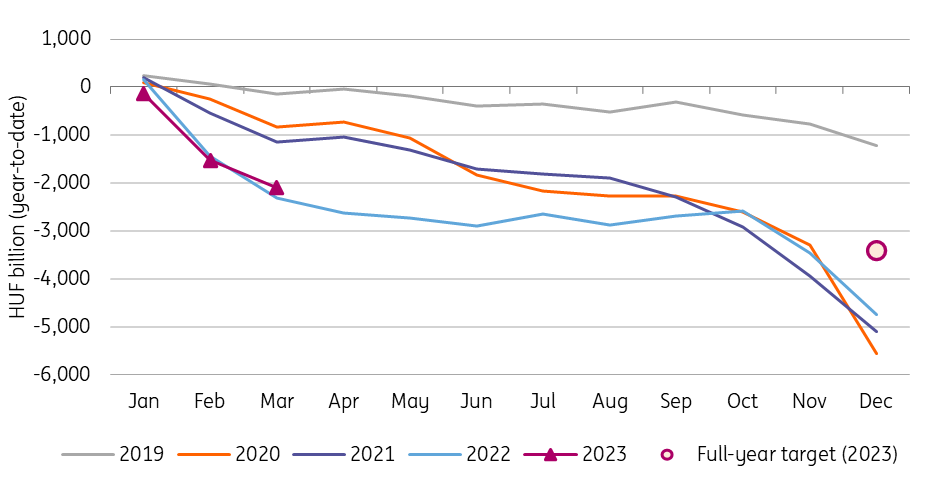This year’s Hungarian budget is manageable, but 2024 looks bleaker
The budgetary situation in the first quarter of 2023 is eerily similar to last year’s developments. The biggest challenge remains the rising debt service cost and the foggy future of EU funds. An update from 12 April, with corrected figures
This year is no different than 2022, at least when it comes to budgetary developments. Or to be precise, the March monthly deficit is pretty much in the range what we used to see in previous years. The monthly deficit generated in the budget amounts to HUF 564.6bn, pushing the year-to-date shortfall to close to HUF 2,090bn. This equals 61% of the full-year cash-flow based deficit target.
Budget performance (year-to-date, HUFbn)

The deficit accumulation used to be frontloaded. In this regard, this year makes the picture bleaker as the Hungarian economy will probably hit the bottom in the current mini crisis at the beginning of 2023. This makes the revenue generation more challenging, though the high inflation is there to compensate, partially. Moreover, as the Ministry of Finance pointed out in its press release, expenditures increased by 12% year-on-year during the first three months of this year. This is a result of the fact that the budget used to compensate energy suppliers during the heating season and the 2023 heating season became more costly than last year’s. On top of this, the significant (15%) increase in pensions complemented by the extra (13th month) pension payments provide a significant burden to the budget during the first quarter.
The twelve-month rolling budget deficit in Hungary

With the heating season is over, we see some improvement in the budget situation in the coming months. The government maintains the freeze on public investment activity as well, which could also help meeting this year’s deficit target. The biggest challenges remain the debt service cost and the inflation. Regarding the former, the latest EDP Report says that debt service cost (based on an accrual-based calculation) will almost hit HUF 3tn in 2023, which means a major burden on the expenditure side. As inflation seems stubbornly high, it might delay the start of the rate cut cycle, keeping the interest rates and bond yields elevated for longer, generating more pressure on budget's debt service costs. But inflation also poses risk to another element on the expenditure side: pension. Pensions are tied to inflation and the government calculated with a 15% price pressure in 2023. However, the latest upside surprise in March might mean that this year's inflation will be rather around 19%, triggering a total HUF 200-300bn (0.30-0.45% of GDP) adjustment need in pensions.
This is clearly reducing the room for manoeuvre for the government when it comes to supporting the economy. Moreover, if the government wants to meet the 3.9% deficit-to-GDP target (accrual based, Maastricht deficit), it needs to tailor a zero primary budget balance (so the deficit except for interest payments), knowing that this year's interest rate expenditure is HUF 2,976bn versus the planned HUF 3,062bn EDP deficit figure. Against this backdrop, this year is a year of a significant tightening in the fiscal policy. However, the expected inflow of the EU funds could help a lot from a cash-flow perspective. Our base case scenario is that the government will settle the dispute and money will start flowing during the second half of this year. With that view, we think both the EDP and the cash-flow based deficit targets will be met. The Ministry of Finance underscored this as well, that the government will make every necessary step to meet this year’s targets.
So, this year’s deficit situation looks manageable. But what about next year? The debt service cost could increase further, while the 2024 preliminary budget plan (based on last year’s Convergence Programme) contained a 2.5% of GDP deficit target, so sees further tightening. In this regard, next year looks more than challenging from a fiscal point of view. We would not be shocked if next year’s official budget deficit plan would contain a higher target. But even with that, we see a significant risk that the government won’t have the opportunity to phase out the windfall taxes from a fiscal point of view. On one hand, this would be good news from a fiscal consciousness perspective, on the other hand bad news for businesses and consumers who can face yet another round of pass-through of the unexpected tax burden in consumer prices.
This article has been updated. In our original article, we wrongly suggested that the current 2,500 billion interest expenses had increased to HUF 2,976 billion for this year based on the EDP report. However, this does not correspond to reality, because this year's interest expenditure amount of HUF 2,500 billion is a cash flow-based amount, while the amount of HUF 2,976 billion is an accrual-based amount.
This publication has been prepared by ING solely for information purposes irrespective of a particular user's means, financial situation or investment objectives. The information does not constitute investment recommendation, and nor is it investment, legal or tax advice or an offer or solicitation to purchase or sell any financial instrument. Read more
Download
Download snap